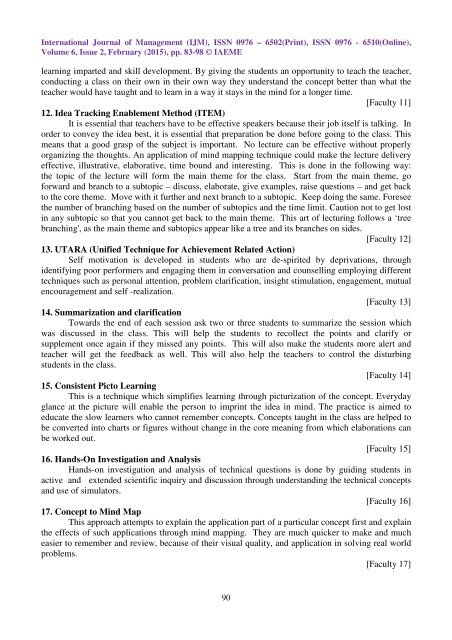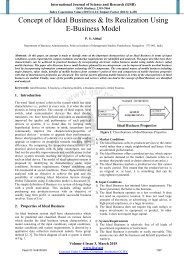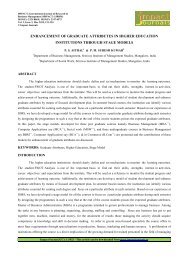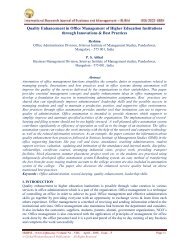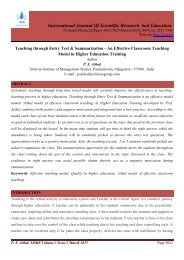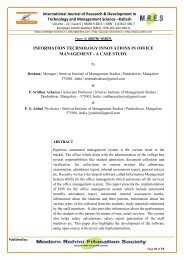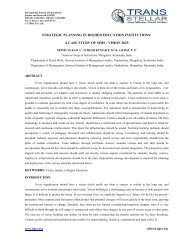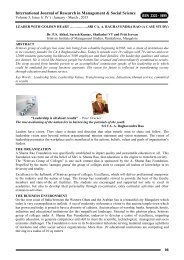How Innovations and Best Practices can Transform Higher Education Institutions : A case study of SIMS
Education has become competitive so as the educational institutions. In order to survive the competition, institutions have to improve the quality of their services. Changes in culture, aspiration and levels of skills required in securing employment for students, force higher education institutions today to rework on their educational models and add value to each and every aspect of their service. Innovations and best practices serve to enhance quality and add value. Srinivas Institute of Management Studies (SIMS), which combines technology, management and social service education has identified and implemented innovations and best practices to differentiate itself among the competitors and to add value in its educational services. In this paper, we have discussed innovations, small and big, develped indigineously and implemented during last four years. They are broadly classified under six key aspects namely "curricular aspects, teaching-learning and evaluation, research, consultancy and extension, infrastructure and learning resources, student support and progression, and governance, leadership, and management". The paper also contains some of the intitutional and individual faculty best practices having visible impact on the quality of higher education imparted by the institution. The best practices concern admission, fees, attendance, teaching, performance, skill building, employability, student involvement, collective learning, value addition, ensuring transparency, information dessimination etc. Finally two institutional best practices are elaborated with its aim of practice, underlying principles and concepts, particular contextual features or challenging issues that have had to be addressed in designing and implementing the practice, and its implementation, including its uniqueness in Indian higher education, evidence of success, identifying the problems encountered and resources required to implement the practice.
Education has become competitive so as the educational institutions. In order to survive the competition, institutions have to improve the quality of their services. Changes in culture, aspiration
and levels of skills required in securing employment for students, force higher education institutions
today to rework on their educational models and add value to each and every aspect of their service. Innovations and best practices serve to enhance quality and add value. Srinivas Institute of
Management Studies (SIMS), which combines technology, management and social service education
has identified and implemented innovations and best practices to differentiate itself among the competitors and to add value in its educational services. In this paper, we have discussed
innovations, small and big, develped indigineously and implemented during last four years. They are
broadly classified under six key aspects namely "curricular aspects, teaching-learning and evaluation, research, consultancy and extension, infrastructure and learning resources, student support and progression, and governance, leadership, and management". The paper also contains some of the
intitutional and individual faculty best practices having visible impact on the quality of higher education imparted by the institution. The best practices concern admission, fees, attendance, teaching, performance, skill building, employability, student involvement, collective learning, value
addition, ensuring transparency, information dessimination etc. Finally two institutional best practices are elaborated with its aim of practice, underlying principles and concepts, particular contextual features or challenging issues that have had to be addressed in designing and implementing the practice, and its implementation, including its uniqueness in Indian higher
education, evidence of success, identifying the problems encountered and resources required to implement the practice.
Create successful ePaper yourself
Turn your PDF publications into a flip-book with our unique Google optimized e-Paper software.
International Journal <strong>of</strong> Management (IJM), ISSN 0976 – 6502(Print), ISSN 0976 - 6510(Online),<br />
Volume 6, Issue 2, February (2015), pp. 83-98 © IAEME<br />
learning imparted <strong>and</strong> skill development. By giving the students an opportunity to teach the teacher,<br />
conducting a class on their own in their own way they underst<strong>and</strong> the concept better than what the<br />
teacher would have taught <strong>and</strong> to learn in a way it stays in the mind for a longer time.<br />
[Faculty 11]<br />
12. Idea Tracking Enablement Method (ITEM)<br />
It is essential that teachers have to be effective speakers because their job itself is talking. In<br />
order to convey the idea best, it is essential that preparation be done before going to the class. This<br />
means that a good grasp <strong>of</strong> the subject is important. No lecture <strong>can</strong> be effective without properly<br />
organizing the thoughts. An application <strong>of</strong> mind mapping technique could make the lecture delivery<br />
effective, illustrative, elaborative, time bound <strong>and</strong> interesting. This is done in the following way:<br />
the topic <strong>of</strong> the lecture will form the main theme for the class. Start from the main theme, go<br />
forward <strong>and</strong> branch to a subtopic – discuss, elaborate, give examples, raise questions – <strong>and</strong> get back<br />
to the core theme. Move with it further <strong>and</strong> next branch to a subtopic. Keep doing the same. Foresee<br />
the number <strong>of</strong> branching based on the number <strong>of</strong> subtopics <strong>and</strong> the time limit. Caution not to get lost<br />
in any subtopic so that you <strong>can</strong>not get back to the main theme. This art <strong>of</strong> lecturing follows a ‘tree<br />
branching', as the main theme <strong>and</strong> subtopics appear like a tree <strong>and</strong> its branches on sides.<br />
[Faculty 12]<br />
13. UTARA (Unified Technique for Achievement Related Action)<br />
Self motivation is developed in students who are de-spirited by deprivations, through<br />
identifying poor performers <strong>and</strong> engaging them in conversation <strong>and</strong> counselling employing different<br />
techniques such as personal attention, problem clarification, insight stimulation, engagement, mutual<br />
encouragement <strong>and</strong> self -realization.<br />
[Faculty 13]<br />
14. Summarization <strong>and</strong> clarification<br />
Towards the end <strong>of</strong> each session ask two or three students to summarize the session which<br />
was discussed in the class. This will help the students to recollect the points <strong>and</strong> clarify or<br />
supplement once again if they missed any points. This will also make the students more alert <strong>and</strong><br />
teacher will get the feedback as well. This will also help the teachers to control the disturbing<br />
students in the class.<br />
[Faculty 14]<br />
15. Consistent Picto Learning<br />
This is a technique which simplifies learning through picturization <strong>of</strong> the concept. Everyday<br />
glance at the picture will enable the person to imprint the idea in mind. The practice is aimed to<br />
educate the slow learners who <strong>can</strong>not remember concepts. Concepts taught in the class are helped to<br />
be converted into charts or figures without change in the core meaning from which elaborations <strong>can</strong><br />
be worked out.<br />
[Faculty 15]<br />
16. H<strong>and</strong>s-On Investigation <strong>and</strong> Analysis<br />
H<strong>and</strong>s-on investigation <strong>and</strong> analysis <strong>of</strong> technical questions is done by guiding students in<br />
active <strong>and</strong> extended scientific inquiry <strong>and</strong> discussion through underst<strong>and</strong>ing the technical concepts<br />
<strong>and</strong> use <strong>of</strong> simulators.<br />
[Faculty 16]<br />
17. Concept to Mind Map<br />
This approach attempts to explain the application part <strong>of</strong> a particular concept first <strong>and</strong> explain<br />
the effects <strong>of</strong> such applications through mind mapping. They are much quicker to make <strong>and</strong> much<br />
easier to remember <strong>and</strong> review, because <strong>of</strong> their visual quality, <strong>and</strong> application in solving real world<br />
problems.<br />
[Faculty 17]<br />
90


